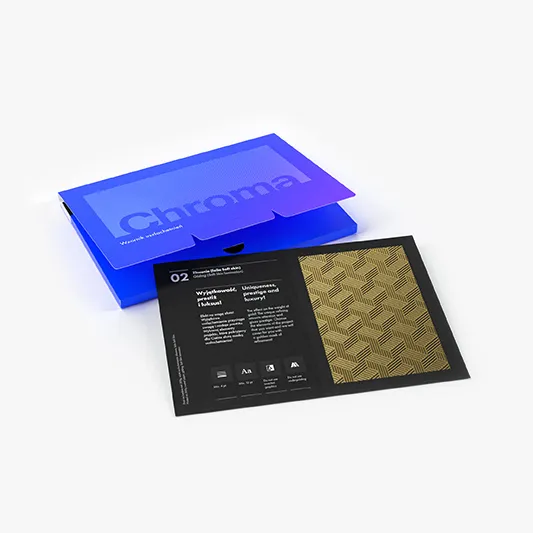
Dziękujemy za
założenie konta.
Twój prezent
już do Ciebie leci!
Finishing Templates
Some product prices in cart have been updated according to the current discounts applicable for this account. Find the list of updated products below:

Dziękujemy za
założenie konta.
Twój prezent
już do Ciebie leci!
Some product prices in cart have been updated according to the current discounts applicable for this account. Find the list of updated products below:
Use the finishing templates to enhance any printed materials you order. Personal business cards, presentation folders, election posters or wall calendars – you can enhance them to make them stand out. With extra finishing, the visuals will also become more functional – more resistant to wear and tear.
In printing services, finishing involves highlighting a certain feature of the printed product. This is related to the original meaning of the word ‘finishing,’ also in a general sense. According to dictionary, it means ‘to add final touches,’ and to enhance the properties of a specific substance or product. In the printing industry, finishing means covering the surface of the print with certain substances.
Print finishing is more than just boosting the visual effects. Application of film coatings or UV 3D varnish changes the tactile quality of print too. And touch is one of crucial human senses. With touch, we can feel temperature changes, the shape of objects, the properties of their textures. It also has an important alarming function as it allows us to receive pain stimuli.

When we shop and make contact with objects, tactile signals are very strong. We love to rub and stroke objects or run our fingers over a fabric or a sheet of printed paper, as if we were in the midst of a sensory test.
This also applies to the world of new technologies. Smartphones attract our attention even when we need to mute them. We can feel the vibrations caused by an incoming social media message or email and we automatically reach for the phone.
Let’s take this to a regular street. Raised dotted markings placed on the pavement before a zebra crossing instantly attract our attention. Even if we are being absent-minded or, on the contrary, highly focused on the conversation we are having.
Our reaction is the same when we touch printed materials, which is why print should be interesting and offer a pleasant tactile feel. This is what finishings are for. However, not everyone will find verbal descriptions of specific finishings useful.
A graphic designer preparing the design of a flyer or a business card needs to know the effect of particular types of print finishing. In other words, he or she must perform a special sensory test by touching paper that has been enhanced using a specific method.
To meet those needs, Chroma offers finishing templates. They serve as a visual and tactile guide for all those who design business cards, company folders or calendars. Every card contains specifically enhanced print and a description of every finish in two languages: in Polish and in English.
You can use them as guidelines to choose the type of finishing you would like for your design. This is particularly helpful when you are ordering the printing of small products, such as business cards. They require high design precision.
The finishing template will also help you in your work with customers. If you order a finishing template, you will be able to show your customer the final effect of a specific design after printing. You will save the time otherwise often wasted on email communications, phone calls and meetings connected with the customer's failure to fully grasp the design.
Even a most experienced graphic designer does not know all the details of the printing industry production process or the properties of all modern printing machines. What looks a certain way on computer screen and seems to be the desired effect may look slightly different once printed. With the templates offered by Chroma, you can avoid unpleasant surprises and enjoy your work.
The maximum available order limit for finishing templates is ten.
